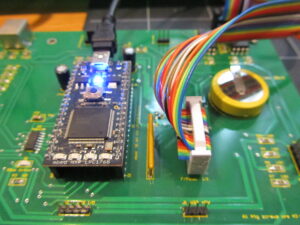Your basket is currently empty!
Ovation SCA-1: A high performance fully balanced line pre-amplifier
Originally published in 2010
Here is the result of my investigation in to a fully balanced high performance, low distortion line pre-amp, the ‘Ovation’ Stereo Control Amplifier One’.
I drew some inspiration for this project after reading about the TEAC Esoteric line preamp, which is also based on the TI PGA2320, and received rave reviews from the hi-end press. Esoteric have stuck with the PGA2320 in subsequent models of their line pre-amp and continued to garner excellent reviews. Michael Fremer, of Sterophile fame, said it was one of the best line preamps he had heard at any price – the Esoteric goes for about $10k.
How does my SCA-1 sound? Very open with a smooth mid and upper range. DC coupling throughout means there are no nasties in the LF area either, and overall imaging is excellent.
Ovation SCA-1 Circuit Diagrams
This design is a dual mono fully balanced line pre-amp. Input balanced source selection is via relays, under CPU control via a serial optically isolated bus. The output from the source selection feeds into a dual LM4562 high resolution audio op-amp buffer, and this then feeds into a TI PGA2320, which is configured as a balanced volume control stage. The balanced output from the PGA2320 feeds into an inverting stage configured around an LM4562, with each half of the LM4562 driving an LME49600 buffer. The LM49600’s are inside the LM4562 feedback loop in order to minimize distortion. Since this pre-amp is DC coupled from input throught to output, a servo configured around an AD8512 dual op-amp ensures output offsets are limited to around 200uV worst case.The headphone amplifer is built around an LME49710 high resolution audio op-amp, and the LME49600, again, the buffer inside the op-amp’s feedback loop for the lowest possible distortion.
The entire pre-amp is controlled by an NXP LPC1768 32 bit ARM controller from mbed (see www.mbed.org). The controller is fully optically isolated from the main analog board in order to ensure there are NO noise problems, with separate optically isolated serial busses for each channel. The operating program is written in C and ended up at about 120k bytes including the graphics (the actual I/O part is about 20k bytes long) and is interrupt driven, so when not executing commands from the front panel controls or the remote control, the CPU shuts down, minimizing noise and power consumption. Of course, the use of the optically isolated serial bus also has a big impact on noise performance, where I am aimed for something well under -110dB worst case.
Comments
5 responses to “Ovation SCA-1: A high performance fully balanced line pre-amplifier”
-
Yes – Cirrus Logic CS3308 here https://www.cirrus.com/products/cs3308-18/
Note that the max supply rail is +-9 V and not +-15 V that you get on the PGA types from TI.Nevertheless, I have heard it is a good chip from another designer who did a project for an audio company using it.
-
Any good replacement for PGA2310 ? This is a very expensive part.
I am using 6 channels. -
Very nice work…
I would like to implement a similar design, but in an unbalanced configuration. This one being a dual-mono setup, a single balanced channel could be used as a stereo configuration. Or am I thinking wrong? What are the implications in redesigning a balanced to an unbalanced circuit?
Regards,
Rudolph -
Thanks for the feedback Roberto.
-
Hello from Italy, great great job !
I’m working around something similar but with a touchscreen color LCD and everything driven by an ATMega32 (with an optical rotary encoder+PGA2311 for the volume control).
I’m also building an amp (based on the P101 of Rod Elliott) where the softstart, the protections (DC out, thermal, undervoltage etc.) are controlled with an ATMega16. I’m also trying to implement a wattmeter to display on a color LCD, the RMS output power level (and other info) using an Allegro ACS712-30 (to measure the output current) and an AD736 to read the RMS value of the output voltage then calculate the RMS power.It will take a long time to complete “the equipment” but…surely you know what I mean.Keep up the good work, regards.
Roberto




Leave a Reply